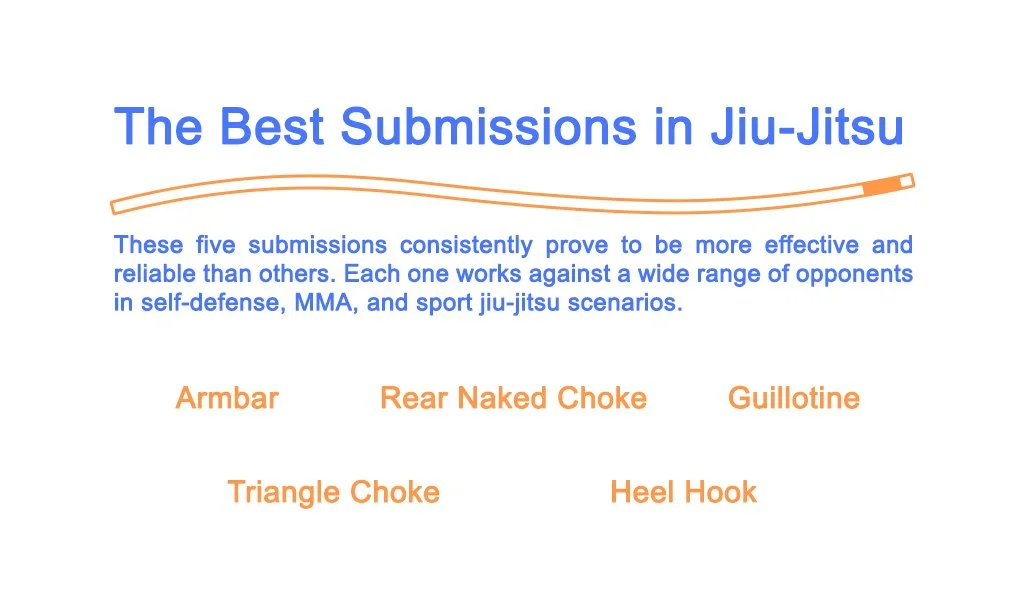What Are the Best Submissions in Jiu-Jitsu?
The end goal of jiu-jitsu is to submit your opponent. But with so many submission techniques to choose from, beginners often struggle to identify which jiu-jitsu submissions are best.
Some grappling techniques are far more reliable and effective than others. For example, the best submissions in jiu-jitsu are:
Rear naked choke
Armbar
Guillotine
Triangle choke
Heel hook
Those submissions are the ones you'll witness most often if you watch grappling competitions and mixed martial arts. This article will focus on the strengths of each one.
Rear Naked Choke
Jiu-jitsu practitioners perform the rear naked choke by positioning themselves behind their opponent, wrapping their arm around their opponent's neck, and squeezing to reduce blood flow to the brain. With correct application, this submission will cause unconsciousness if the opponent refuses to tap out. There are two primary reasons why the rear naked choke is the top submission in grappling.
First, you can perform the rear naked choke while maintaining one of the most controlling positions in jiu-jitsu—back control. When attempting a rear naked choke from back control, the risk of losing your dominant position is exceptionally low.
Second, the rear naked choke works on nearly every opponent. While it's possible for a strong competitor to use the strength and size of their arm to resist an armlock, it's almost impossible for them to withstand a fully locked-in rear naked choke. With just a few pounds of pressure applied to the correct part of an opponent's neck, a jiu-jitsu practitioner can render their opponent unconscious.
Armbar
The armbar illustrates one of the core concepts of jiu-jitsu—that you should seek to employ the strength of your entire body against just one of your opponent's body parts. The most widespread version of the armbar uses your back and leg muscles to straighten your opponent's arm. Once the arm is straight, you can raise your hips and use your pelvic bone as a fulcrum to hyperextend your opponent's elbow.
Armbars are available from many positions, including guard, mount, back control, and many more. Combining that availability with the leverage this move employs makes the armbar one of the most formidable submissions in a jiu-jitsu practitioner's arsenal.
Guillotine
Guillotine chokes are easy to apply and occur most often in the front headlock position. This choke is like the rear naked choke in that once you apply a guillotine correctly, the strength and size of your opponent will do little to negate the effectiveness of the choke.
Ironically, the readily available nature of a guillotine choke can be a positive and a negative. On the one hand, the guillotine choke can be an excellent counter to some of the most popular takedowns in grappling—double and single-leg takedowns. However, many grapplers are aware of that threat and are well-versed in anticipating and escaping from front headlocks and guillotine chokes.
Despite that paradox, the guillotine choke belongs in the repertoire of any skilled grappler. Fortunately, there are many guillotine variations, each of which offers a different kind of control and places pressure on your opponent's neck in a different way. If you find a guillotine style you like and know when and how to apply it, this submission will be a potent part of your grappling style.
Triangle Choke
Triangle chokes involve wrapping your legs in a figure four around your opponent's head and one of their arms. You can complete the choke to achieve a submission, maintain control over your opponent's upper body, and transition to other submissions and sweeps from that position.
As with many jiu-jitsu submissions, the triangle choke has many different variations. The most common variation occurs in the guard position, where the practitioner on the bottom lifts their hips and uses their legs to trap their opponent's head and arm. However, there are many other positions from which the triangle choke is available.
Heel Hook
Heel hooks are somewhat of a misnomer as they primarily cause damage to the knee rather than the heel. When using a heel hook, a jiu-jitsu practitioner will hold their opponent's leg in place and twist their heel, causing torsion to the knee ligaments.
Lower body submissions, like heel hooks, ankle locks, and kneebars, have been a part of jiu-jitsu for a long time. However, they have grown immensely in popularity in recent decades and have become one of the most frequently used submissions in competitive grappling competitions.
However, the rise in heel hook popularity has had some pushback. The main reason for that opposition is that heel hooks can cause ligament tears that alter or even end a practitioner's career. There are indeed other, more dangerous, grappling situations than attacking a leg lock. However, anyone practicing heel hooks must do so with immense caution.
When you begin training, you'll notice that many gyms and tournaments do not allow beginners to use heel hooks. Practicing heel hooks while you are inexperienced or practicing them with someone who is inexperienced is unwise. Still, once you have gained enough experience and control, you'll find that heel hooks are one of the most compelling submissions in jiu-jitsu.
Conclusion
If you want to submit your opponents, you'll need to practice the submission moves that are most likely to achieve that result. There are many jiu-jitsu submissions to consider, but the five we've listed above are the best you can use.
Related Posts
What Are the Main Positions in Jiu-Jitsu?
Can You Break Someone's Arm with an Armbar?
What is the Best Position in Jiu-Jitsu?
Do You Have Questions or Comments About this Post?
If so, please send us a message via our contact page.
